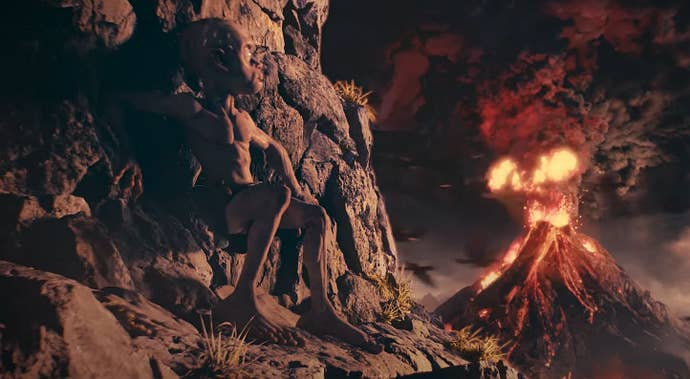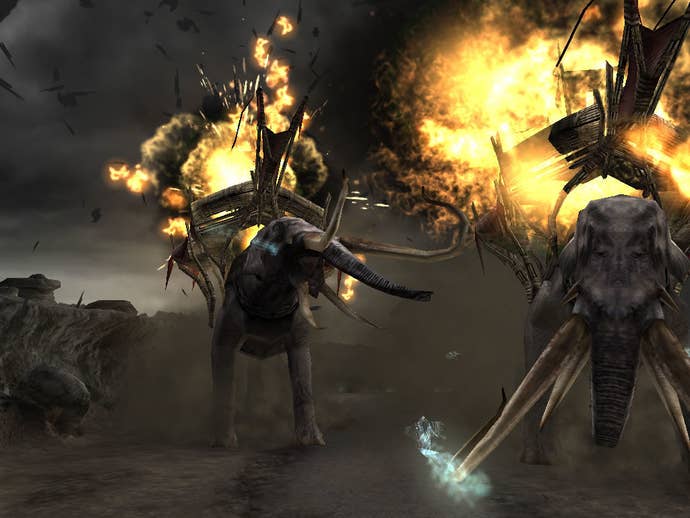Amazon's Lord Of The Rings: The Rings of Power is great, but the games need to reach PS2-era brilliance again
No, thank you! We don’t want any more Lord of the Rings spin-offs, expansions, or distant relations!
It’s been over 20 years since we first set off from The Shire with Frodo and Sam on their quest to destroy the Ring of Power, and despite a series of lacklustre Hobbit films doing their best to extinguish it, the passion still burns hot as the fires of Mount Doom for that quintessential trilogy of fantasy epics. In the times before and since those releases, with the exception of Tolkien’s other literary works, fans have relied heavily on video game interpretations to continue their direct relationship with the characters, settings, and stories of Middle-earth and the One Ring.

But, after a series of spin-offs and non-canon additions slowly boiling the purity of the IP down to directionless mediocrity, it’s critical that future iterations endeavour to recapture the familiarity and emotion that comes with being part of something that you believe in before it’s even begun. That’s right — I’m talking about movie tie-ins. Look, you might scoff, and I wouldn’t blame you for doing so considering tie-in history, but Electronic Arts mastered this in the early noughties with their direct film-to-game releases of The Two Towers and The Return of the King, and it’s about time that we reached for the same dizzying heights of success.
A lot of the complication revolves around licensing, and we don’t want to get too bogged down in that. But to summarise, The Lord of the Rings, The Hobbit, and the rest of Tolkien’s works fall under an extremely complex network of rights that gives even Goldeneye a run for its money. But the fundamentals can be worked out when it comes to game development. The Tolkien Estate, at one time, held all the rights to all of Tolkien’s works. Over time, these rights have changed hands and have been split into different sections, ultimately resulting in Lord Of The Rings and The Hobbit falling under one banner, whilst the rest of his works (such as The Silmarillion and The Unfinished Tales) fall under another.
You then have to split down what media format they’re licensed to produce and which elements of the material they’re allowed to use. For example, the recently released – and divisive – The Rings of Power TV show from Amazon was licensed directly from the Tolkien Estate to be developed using the appendices from The Lord of the Rings only. Though this still affords them a lot of material to work with (as the appendices contain swathes of information concerning major event chronology, detailed family trees, and a history of Middle-earth’s rulers), it does mean that they can’t use any of that original epic story — so they’ve had to get creative with recognisable characters and locations to give us those crowd-pleasing elements.

So what about games? Well, up until recently, Middle-earth Enterprises owned all the literary rights to LOTR and The Hobbit, and earlier this month we heard the announcement that Private Division, a publishing label of Take-Two Interactive Software, Inc. has signed a deal with Wētā Workshop to create a brand new game set within the realm of LOTR. This is very exciting for two reasons: firstly, this was done with full series licensing granted from Middle-earth Enterprises, meaning that this new game will be able to use all of the lore, characters, and – most importantly – the story from the full range of Hobbit/LOTR novels.
The second reason is that Wētā Workshop is no average developer — it was an instrumental special effects/prop company in the production of the original Lord of the Rings films, setting itself up as an interactive game division in 2014. So just like that, we have all of the source material in place to create a modern game based on the most beloved fantasy story of all time. And we also have a developer that was there all those years ago; one that can understand from a production perspective what made the films so special.
The only spanner in the works is the recent acquisition of all those literary rights, as well as pretty much every other right you can think of, by video game holdings company giant, The Embracer Group, which recently entered into an agreement to buy Middle-earth Enterprises. However, we have no reason to believe anything will change with regard to the game’s development following Embracer’s public statement promoting a push for the more prolific use of the IP to develop new games and films, so we’ll assume all is good for now.

But getting the rights to create a great game is only part of the battle. Daedalic Entertainment's upcoming industry enigma, The Lord of the Rings: Gollum, is also licensed to use the books at will. Daedalic has opted to tell the story of Gollum after he escaped Barad-dur – meaning that it’s telling a story outside of the books’ scope, despite using characters and settings from them. It could be the lack of gameplay information, poor publicity, or the delays to launch, but the middling interest in the title has continued to wane ever since its announcement in 2019.
Ultimately, though, could it simply be because we don’t really care? Gollum is a fantastic character, but our fascination with him has always been in his interaction with Bilbo and the Fellowship within Tolkien’s brilliantly written tales. Once you remove him from that setting, you’re just theorising, writing new material; and why would you do that? Whether you’re fans of the books or the films, the constant is clear — the source material is king.
The Shadow of Mordor/War series of games offered us another modern licensed experience in an open-world, non-canon history of Mordor, which shamelessly mixed legitimate history with shoe-horned appearances of crowd-pleasing favourites — seriously, whose idea was it to sexualise Shelob? They weren’t bad games, and they worked as third-person action adventures, featuring a brilliant (and now patented) Nemesis system, but the question remains… did we feel excited to be a part of this world again, or were these bastardised interpretations simply utilising a convenient setting in which to sell a game? If you can enjoy them for what they are, that’s great. But I wouldn’t blame you for the more cynical conclusion.


There have been some great games released under the LOTR banner, don’t get me wrong. The Battle for Middle-earth RTS series was good fun and captured the scale of war nicely, sticking much more closely to the canon than most, with evil campaigns and alternate resolutions thrown in for good measure and fun. But the truth is that there’s still an itch in the video game realm for LOTR fans that hasn’t been scratched since those early 00s movie tie-ins. And the reality is that these games weren’t special in any particular way, really. They didn’t need to introduce shiny new mechanics or expand upon the setting dramatically. In fact, they’re pretty basic hack-and-slash titles, but they made a conscious effort to forego such frivolities in favour of focusing on letting you do one thing: relive the cinematic experience.
The Lord of the Rings: The Two Towers was actually a fairly rushed gaming experience that captured both of the first two films in about six hours of gameplay. But despite this, taking the role of key characters in familiar scenes was an incredible romp. Crossing swords as Aragorn to defeat Lurtz and avenge Boromir, or kicking down ladders from the ramparts of Helm’s Deep during the rapturous climax, felt incredibly satisfying. The whole game was peppered with seamless transitions to actual footage from the films, once again blurring the line between viewer and player. The follow-up title took everything the first game did, but found ways to improve it, such as adding a larger roster of playable characters and increasing the number of enemies that could appear on screen at any one time, blowing us away with its scale. These games didn’t try to reinvent the wheel; they only refined it.

Despite their simple design philosophy and limited visual fidelity by today’s standard, both titles were considered some of – if not the finest – movie-to-video-game adaptations at that point in time. The Lord of the Rings is arguably the greatest story ever told; we feel connected to Frodo, Sam, and the Fellowship’s journey together, and it’s that beautiful connectedness that many fans yearn for once again. Let’s not get ahead of ourselves, there’s nothing to suggest yet that Wētā Workshop will even create a game that ties itself to the original story, but their history with the franchise and the wealth of material available to them certainly signals that this is the best chance we’ve had so far for the purest LOTR gaming experience in 20 years.

The original tie-ins are old and certainly dated, but they hold a core philosophy in place that celebrated a series adored by millions. The Lord of the Rings fandom has endured for decades without wavering in its passion — surely it would welcome a celebration of where it all began once more? Forget sexy Shelob; I’d take Samwise the Brave any day.
